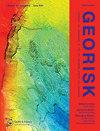Interpretation of spatio-temporal variation of precipitation from spatially sparse measurements using Bayesian compressive sensing (BCS)
IF 4.8
3区 工程技术
Q1 ENGINEERING, GEOLOGICAL
Georisk-Assessment and Management of Risk for Engineered Systems and Geohazards
Pub Date : 2023-03-16
DOI:10.1080/17499518.2023.2188464
引用次数: 1
Abstract
ABSTRACT Precipitation might change rapidly and vary spatially, therefore, knowledge on spatio-temporal variation of precipitation plays a pivotal role in water resources management, hydrogeological hazard and risk assessment, and city resilience enhancement. However, precipitation monitoring data are collected through a limited number of precipitation stations in practice, and they are often sparse and discontinuous, particularly in spatial domain. Furthermore, regional precipitation data exhibits characteristics of seasonality, periodicity and highly non-stationarity on a long-time scale. Therefore, it is challenging to obtain a spatio-temporal variation of precipitation with high spatial resolution from monitoring data measured at a limited number of precipitation stations. To address these challenges, this study develops a non-parametric spatio-temporal Bayesian compressive sensing (ST-BCS) method for interpolation of spatio-temporally varying, but sparsely measured precipitation data in the spatial domain. The proposed method is able to not only provide precipitation interpolation results with high spatial resolution from a limited number of monitoring stations, but also quantify the associated interpolation uncertainty simultaneously. In addition, ST-BCS is directly applicable to the non-stationary spatio-temporal meteorological data. Furthermore, real precipitation datasets are established to benchmark different spatio-temporal interpolation methods. The benchmarking results show that the proposed ST-BCS method performs well and outperforms the spatial BCS method.基于贝叶斯压缩感知(BCS)的空间稀疏降水时空变化解释
摘要降水可能变化迅速,空间变化较大,因此,了解降水时空变化对水资源管理、水文地质灾害和风险评估以及增强城市抵御能力具有重要作用。然而,在实践中,降水监测数据是通过数量有限的降水站收集的,而且这些数据往往是稀疏和不连续的,特别是在空间领域。此外,区域降水数据在长期尺度上表现出季节性、周期性和高度非平稳性的特征。因此,从有限数量的降水站测量的监测数据中获得具有高空间分辨率的降水时空变化是一项挑战。为了应对这些挑战,本研究开发了一种非参数时空贝叶斯压缩感知(ST-BCS)方法,用于在空间域中对时空变化但测量稀少的降水数据进行插值。所提出的方法不仅能够从有限数量的监测站提供高空间分辨率的降水插值结果,而且能够同时量化相关的插值不确定性。此外,ST-BCS直接适用于非平稳时空气象数据。此外,还建立了真实的降水数据集,对不同的时空插值方法进行了基准测试。基准测试结果表明,所提出的ST-BCS方法性能良好,优于空间BCS方法。
本文章由计算机程序翻译,如有差异,请以英文原文为准。
求助全文
约1分钟内获得全文
求助全文
来源期刊
CiteScore
8.70
自引率
10.40%
发文量
31
期刊介绍:
Georisk covers many diversified but interlinked areas of active research and practice, such as geohazards (earthquakes, landslides, avalanches, rockfalls, tsunamis, etc.), safety of engineered systems (dams, buildings, offshore structures, lifelines, etc.), environmental risk, seismic risk, reliability-based design and code calibration, geostatistics, decision analyses, structural reliability, maintenance and life cycle performance, risk and vulnerability, hazard mapping, loss assessment (economic, social, environmental, etc.), GIS databases, remote sensing, and many other related disciplines. The underlying theme is that uncertainties associated with geomaterials (soils, rocks), geologic processes, and possible subsequent treatments, are usually large and complex and these uncertainties play an indispensable role in the risk assessment and management of engineered and natural systems. Significant theoretical and practical challenges remain on quantifying these uncertainties and developing defensible risk management methodologies that are acceptable to decision makers and stakeholders. Many opportunities to leverage on the rapid advancement in Bayesian analysis, machine learning, artificial intelligence, and other data-driven methods also exist, which can greatly enhance our decision-making abilities. The basic goal of this international peer-reviewed journal is to provide a multi-disciplinary scientific forum for cross fertilization of ideas between interested parties working on various aspects of georisk to advance the state-of-the-art and the state-of-the-practice.

 求助内容:
求助内容: 应助结果提醒方式:
应助结果提醒方式:


